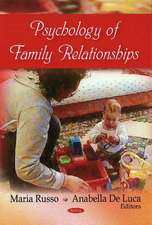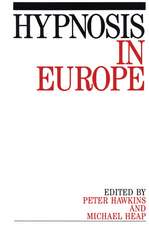Brain and Music
Autor SK Koelschen Limba Engleză Paperback – 12 apr 2012
- Covers a variety of topics fundamental for music perception, including musical syntax, musical semantics, music and action, music and emotion
- Includes general introductory chapters to engage a broad readership, as well as a wealth of detailed research material for experts
- Offers the most empirical (and most systematic) work on the topics of neural correlates of musical syntax and musical semantics
- Integrates research from different domains (such as music, language, action and emotion both theoretically and empirically, to create a comprehensive theory of music psychology
Preț: 339.94 lei
Nou
60.15€ • 70.54$ • 52.83£
Carte tipărită la comandă
Livrare economică 16 februarie-02 martie
Specificații
ISBN-10: 0470683392
Pagini: 322
Dimensiuni: 187 x 235 x 18 mm
Greutate: 0.56 kg
Editura: Wiley
Locul publicării:Chichester, United Kingdom
Public țintă
Music psychology courses, including Music Cognition, Music Perception, Neuroscience of Music, Cognitive Development, and Music EducationDescriere
Making and listening to music engages a large array of psychological processes, including perception, attention, learning and memory, syntactic processing, the processing of meaning, and social cognition. This richness makes music the ideal tool to investigate human psychology and the workings of the human brain, and in recent years neuroscientists have increasingly used this tool to inform and extend their ideas. This book offers a comprehensive survey of the current state of knowledge in the cross–disciplinary field of music psychology.
An expert in his field, Stefan Koelsch establishes basic neuroscientific, music–theoretical, and music–psychological concepts, before presenting the brain correlates of music perception, musical syntax, musical semantics, music and action, and music and emotion.
Koelsch synthesizes all these conceptual threads into a new theory of music psychology. His theory integrates different areas such as music, language, action, and emotion that are traditionally treated as separate domains.
Textul de pe ultima copertă
Making and listening to music engages a large array of psychological processes, including perception, attention, learning and memory, syntactic processing, the processing of meaning, and social cognition. This richness makes music the ideal tool to investigate human psychology and the workings of the human brain, and in recent years neuroscientists have increasingly used this tool to inform and extend their ideas. This book offers a comprehensive survey of the current state of knowledge in the cross–disciplinary field of music psychology.
An expert in his field, Stefan Koelsch establishes basic neuroscientific, music–theoretical, and music–psychological concepts, before presenting the brain correlates of music perception, musical syntax, musical semantics, music and action, and music and emotion.
Koelsch synthesizes all these conceptual threads into a new theory of music psychology. His theory integrates different areas such as music, language, action, and emotion that are traditionally treated as separate domains.
Cuprins
Preface ix Part I Introductory Chapters 1
1 Ear and Hearing 3
1.1 The ear 3
1.2 Auditory brainstem and thalamus 6
1.3 Place and time information 8
1.4 Beats, roughness, consonance and dissonance 9
1.5 Acoustical equivalency of timbre and phoneme 11
1.6 Auditory cortex 12
2 Music–theoretical Background 17
2.1 How major keys are related 17
2.2 The basic in–key functions in major 20
2.3 Chord inversions and Neapolitan sixth chords 21
2.4 Secondary dominants and double dominants 21
3 Perception of Pitch and Harmony 23
3.1 Context–dependent representation of pitch 23
3.2 The representation of key–relatedness 26
3.3 The developing and changing sense of key 29
3.4 The representation of chord–functions 30
3.5 Hierarchy of harmonic stability 31
3.6 Musical expectancies 35
3.7 Chord sequence paradigms 36
4 From Electric Brain Activity to ERPs and ERFs 40
4.1 Electro–encephalography (EEG) 43
4.1.1 The 10 20 system 43
4.1.2 Referencing 45
4.2 Obtaining event–related brain potentials (ERPs) 45
4.3 Magnetoencephalography (MEG) 48
4.3.1 Forward solution and inverse problem 49
4.3.2 Comparison between MEG and EEG 49
5 ERP Components 51
5.1 Auditory P1, N1, P2 51
5.2 Frequency–following response (FFR) 53
5.3 Mismatch negativity 54
5.3.1 MMN in neonates 57
5.3.2 MMN and music 57
5.4 N2b and P300 59
5.5 ERP–correlates of language processing 59
5.5.1 Semantic processes: N400 60
5.5.2 Syntactic processes: (E)LAN and P600 63
5.5.3 Prosodic processes: Closure Positive Shift 67
6 A Brief Historical Account of ERP Studies of Music Processing 70
6.1 The beginnings: Studies with melodic stimuli 70
6.2 Studies with chords 74
6.3 MMN studies 75
6.4 Processing of musical meaning 76
6.5 Processing of musical phrase boundaries 77
6.6 Music and action 77
7 Functional Neuroimaging Methods: fMRI and PET 79
7.1 Analysis of fMRI data 81
7.2 Sparse temporal sampling in fMRI 84
7.3 Interleaved silent steady state fMRI 85
7.4 Activation vs. activity change 85
Part II Towards a New Theory of Music Psychology 87
8 Music Perception: A Generative Framework 89
9 Musical Syntax 98
9.1 What is musical syntax? 98
9.2 Cognitive processes 102
9.3 The early right anterior negativity (ERAN) 109
9.3.1 The problem of confounding acoustics and possible solutions 113
9.3.2 Effects of task–relevance 120
9.3.3 Polyphonic stimuli 121
9.3.4 Latency of the ERAN 127
9.3.5 Melodies 127
9.3.6 Lateralization of the ERAN 129
9.4 Neuroanatomical correlates 131
9.5 Processing of acoustic vs. music–syntactic irregularities 133
9.6 Interactions between music– and language–syntactic processing 138
9.6.1 The Syntactic Equivalence Hypothesis 145
9.7 Attention and automaticity 147
9.8 Effects of musical training 149
9.9 Development 151
10 Musical Semantics 156
10.1 What is musical semantics? 156
10.2 Extra–musical meaning 158
10.2.1 Iconic musical meaning 158
10.2.2 Indexical musical meaning 159
Excursion: Decoding of intentions during musinc listening 161
10.2.3 Symbolic musical meaning 162
10.3 Extra–musical meaning and the N400 163
10.4 Intra–musical meaning 170
Excursion: Posterior temporal cortex and processing of meaning 166
10.4.1 Intra–musical meaning and the N5 171
10.5 Musicogenic meaning 177
10.5.1 Physical 177
10.5.2 Emotional 179
10.5.3 Personal 180
10.6 Musical semantics 181
10.6.1 Neural correlates 181
10.6.2 Propositional semantics 182
10.6.3 Communication vs. expression 182
10.6.4 Meaning emerging from large–scale relations 183
10.6.5 Further theoretical accounts 184
11 Music and Action 186
11.1 Perception action mediation 186
11.2 ERP correlates of music production 189
12 Emotion 203
12.1 What are musical emotions ? 204
12.2 Emotional responses to music underlying mechanisms 207
12.3 From social contact to spirituality The Seven Cs 208
12.4 Emotional responses to music underlying principles 212
12.5 Musical expectancies and emotional responses 216
12.5.1 The tension–arch 218
12.6 Limbic and paralimbic correlates of music–evoked emotions 219
12.6.1 Major minor and happy sad music 225
12.6.2 Music–evoked dopaminergic neural activity 226
12.6.3 Music and the hippocampus 227
12.6.4 Parahippocampal gyrus 231
12.6.5 A network comprising hippocampus, parahippocampal gyrus, and temporal poles 232
12.6.6 Effects of music on insular and anterior cingulate cortex activity 232
12.7 Electrophysiological effects of music–evoked emotions 233
12.8 Time course of emotion 234
12.9 Salutary effects of music making 235
13 Concluding Remarks and Summary 241
13.1 Music and language 241
13.2 The music–language continuum 244
13.3 Summary of the theory 249
13.4 Summary of open questions 258
References 267
Index 303
Notă biografică
Stefan Koelsch is Professor of Music Psychology at the Freie University Berlin. He is a former post–doctoral research fellow at Harvard Medical School, and led an independent Junior Research Group at the Max Planck Institute for Human Cognitive and Brain Sciences in Leipzig. His main areas of research are neurocognition of music, music and emotion, and music therapy.












